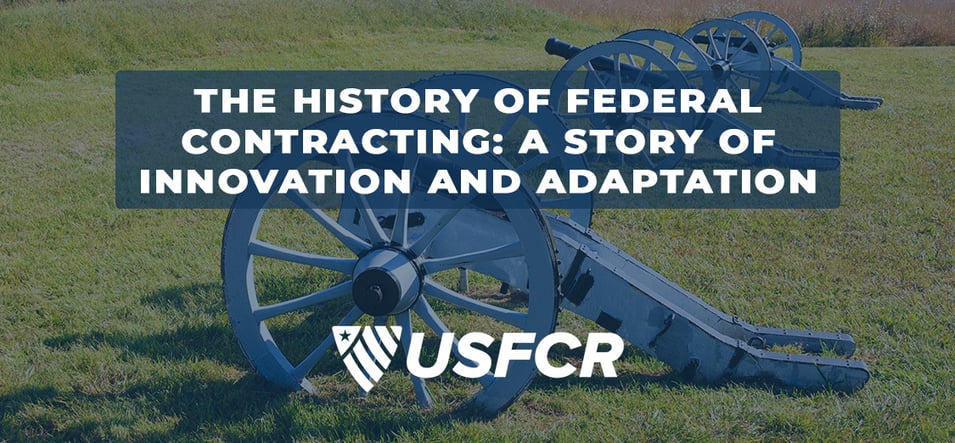Federal contracting in the United States has a rich history that reflects the growth of the nation. It's not just a series of dates and events; it's a story of innovation, resilience, and adaptation that has helped shape America. Here, we'll explore how federal contracting evolved and why understanding this history can provide valuable insights for contractors today.
Early Roots: Revolutionary Beginnings
Imagine the Continental Army during the American Revolution, struggling for supplies. Who stepped in to help? Private businesses, answering the call to provide muskets, food, and other essentials. These early agreements laid the foundation for federal contracting, born out of necessity and fueled by a shared vision for freedom.
In the 19th century, federal contracting expanded as the country grew. Major projects like the Pacific Railway Act of 1862, which led to the construction of the transcontinental railroad, showcased the role of private enterprise in building the nation's infrastructure.
Civil War Era: Building Through Challenges
The Civil War (1861-1865) highlighted both the strengths and challenges of federal contracting. Contractors played a crucial role in supplying the Union Army, but the period was also marred by scandals, with some suppliers providing substandard goods or inflating prices. These challenges underscored the need for regulation and transparency.
20th Century Growth: Innovation and Regulation
During World War I and World War II, federal contracting was essential for supporting the war effort. From weapons to vehicles, contracts helped drive innovation and mass production, contributing to the Allies' victory. This period saw the rise of major defense contractors who remain influential today.
Key regulations also began to shape federal contracting:
-
The Walsh-Healey Public Contracts Act of 1936 set labor standards for federal contracts.
-
The Armed Services Procurement Act of 1947 streamlined procurement to support military needs.
Post-War to Cold War: Expansion and Ethics
The post-war era brought a surge in government spending, especially during the Cold War. Contracts weren't just about defense; they expanded into healthcare, education, and infrastructure. The Federal Property and Administrative Services Act of 1949 created the General Services Administration (GSA) to oversee procurement, ensuring efficient and ethical spending.
Modern Reforms and Technological Revolution
Starting in the 1970s, federal contracting underwent significant reforms to increase transparency and competition. The Competition in Contracting Act (CICA) of 1984 promoted fair competition, while The Federal Acquisition Regulation (FAR) provided a consistent framework to govern procurement.
The digital age brought further transformation. Platforms like SAM.gov made it easier for businesses of all sizes to find and bid on federal contracts, and the Federal Procurement Data System (FPDS) improved transparency. Small business programs, like 8(a) Business Development, Service-Disabled Veteran-Owned Small Businesses (SDVOSB), and Women-Owned Small Businesses (WOSB), ensure that more diverse businesses can compete for government contracts.
Recent Trends: Adaptation and Accountability
In recent years, federal contracting has focused on technology, cybersecurity, and rapid adaptation. Cybersecurity Maturity Model Certification (CMMC) ensures that contractors meet strict security standards, while agile contracting methods have made procurement faster and more responsive to changing needs.
The COVID-19 pandemic highlighted the importance of federal contracting, as the government worked with private contractors to secure medical supplies, logistics support, and vaccine production. The adaptability of federal contracting was critical in managing the crisis.
A Legacy of Progress
Federal contracting has come a long way since the Revolutionary War. Today, it supports a vast range of industries, from defense to disaster relief, with a focus on competition, accountability, and inclusion. For contractors looking to engage with federal opportunities, understanding this history provides a sense of legacy and a guide to navigating the complex world of government procurement.
About USFCR
While the history of federal contracting stretches far beyond recent years, USFCR has been a pivotal player in this landscape since 2010. As the largest and most trusted full-service Federal consulting organization, USFCR has supported over 300,000 clients, providing essential tools like SAM Registration Assistance, GSA Certification, Bid writing, and the Simplified Acquisition Program (SAP).
Though USFCR hasn't been around since the beginning of federal contracting, our impact in the last decade has been profound. We've equipped businesses with the support needed to navigate the complex federal market, fostering growth and success.
Join the legacy of federal contracting with USFCR's proven expertise. Connect with us to explore how we can empower your business in the federal arena.
To speak with a Registration and Contracting Specialist, Call: (866) 216-5343



